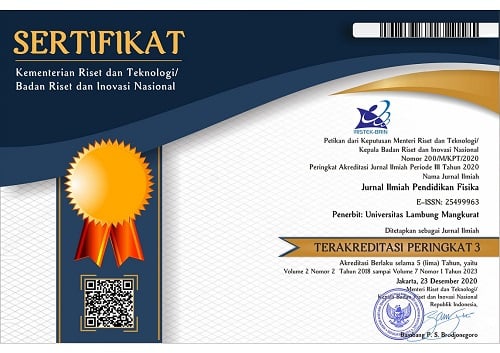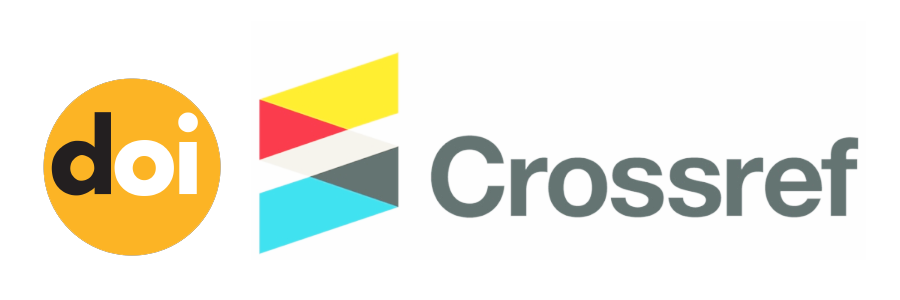The Effectiveness of Hybrid Guided Inquiry for Optimizing HOTS and Communication Skills in Circular Motion Concepts
Abstract
This research was conducted to analyze the effectiveness of Hybrid Guided Inquiry on HOTS and students' communication skills in Circular Motion material. The method used in this research is quantitative research with a quasi-experimental. 10th-grade students of MIPA in SMA Negeri 1 Malang were used as the observed population; the samples taken were students 10 MIPA 2 and 10 MIPA 4. The MANOVA test is a technique used to test hypotheses and then analyze the effectiveness of H-GI in optimizing HOTS and students' communication skills. Analysis of the results of this study found that the HOTS score for the experimental class was 78.4 while for the control class was 71.1. Meanwhile, the communication skills results between the experimental class and the control class were 78 for the experimental class and 72 for the control class. Thus, H-GI is effective in optimizing HOTS and communication skills of students compared to direct learning, which uses PBL. The research results could be the basis for making learning more effective in physics material, especially the Circular Motion concepts.
Keywords
Full Text:
PDFReferences
Akhmalia, N. L., Suana, W. and Maharta, N. (2018) Efektivitas blended learning berbasis lms dengan model pembelajaran inkuiri pada materi fluida statis terhadap penguasaan konsep siswa, JIPFRI (Jurnal Inovasi Pendidikan Fisika dan Riset Ilmiah), 2(2), pp. 56–64. doi: 10.30599/jipfri.v2i2.299.
Alberta, G. (2016) Competencies descriptions, indicators and example.
Apriliani, S., Budiarti, I. S. and Lumbu, A. (2015) Penggunaan analogi dalam pembelajaran fisika melalui metode eksperimen topik aliran arus listrik untuk meningkatkan penguasaan konsep siswa kelas x sma yppk taruna dharma kotaraja, Jurnal Pendidikan Fisika dan Keilmuan (JPFK), 1(1), pp. 14–19. doi: 10.25273/jpfk.v1i1.7.
Ayu, H. D., Pratiwi, H. Y., Kusairi, S., and Muhardjito (2017) Pengembangan e-scaffolding untuk meningkatkan kualitas proses dan hasil belajar, Jurnal Kependidikan, 1(2), pp. 334–347.
Bainamus, P. M., Hartanto and Abdullah, M. I. (2017) Pengaruh model pembelajaran hibrid terhadap kemampuan komunikasi matematika pada sekolah menengah pertama negeri 1 curup tengah, Jurnal Pendidikan Matematika, 1(2), pp. 16–23.
Barikhlana, A., Sholikhan, Jufriadi, A., Ayu, H. D. (2019) The just in time teaching: the effect on student learning achievements viewed from learning motivation, Berkala Ilmiah Pendidikan Fisika, 7(2), pp. 134–140. doi: 10.20527/bipf.v7i2.6402.
Desy, Desnita and Raihananti (2015) Pengembangan alat peraga fisika materi gerak melingkar untuk sma, Prosiding Seminar Nasional Fisika (E-Journal), IV, pp. 39–44.
Hanna, D., Sutarto and Harijanto, A. (2016) Model pembelajaran tema konsep disertai media gambar pada pembelajaran fisika di sma, Jurnal Pembelajaran Fisika, 5(1), pp. 23–29.
Hodiyanto (2019) Pengaruh model problem based learning terhadap higher order thingking skills (hots) matematis siswa, Buana Matematika : Jurnal Ilmiah Matematika dan Pendidikan Matematika, 8(2), pp. 101–108. doi: 10.36456/buana_matematika.8.2:.1750.101-108.
Jariyah, I. A. (2017) Efektivitas pembelajaran inkuiri dipadu sains teknologi masyarakat (stm) untuk meningkatkan kemampuan berpikir kritis pada mata pelajaran ipa, Jurnal Pendidikan Biologi Indonesia, 3(1), pp. 1–9. doi: 10.22219/jpbi.v3i1.3888.
Karyono, Palupi, D. S. and Suharyanto (2009) FISIKA untuk SMA dan MA kelas X. Jakarta: Pusat Perbukuan Departemen Nasional.
Anderson, L. W., and Krathwohl, D. R. (2001) A taxonomy for learning, teaching, and, assessing: A revision of bloom’s taxonomy of educational objectives. New York: Ddison Welsey Lonmon Inc.
Lumbu, A. and Budiarti, I. S. (2015) Peningkatan hasil belajar menggunakan pakem dengan metode diskusi pada pembelajaran fisika dasar pokok bahasan mekanika, Jurnal Pendidikan Fisika dan Keilmuan (JPFK), 1(1), pp. 23–28. doi: 10.25273/jpfk.v1i1.9.
Murni, C. K. and Harimurti, R. (2016) Pengaruh e-learning berbasis schoology terhadap peningkatan hasil belajar siswa dalam materi perangkat keras jaringan kelas x tkj 2 pada smk negeri 3 buduran, Jurnal IT-Edo, 01, pp. 86–90.
Noviansyah, M. I., Mursyid, S. and Sirait, J. (2015) Pengaruh pembelajaran gerak melingkar beraturan berbantuan alat peraga portable board terhadap hasil belajar siswa, Pendidikan Fisika FKIP Untan, pp. 1–12.
Pedaste, M. et al. (2015) Phases of inquiry-based learning: Definitions and the inquiry cycle, Educational Research Review, 14, pp. 47–61. doi: 10.1016/j.edurev.2015.02.003.
Pratiwi, H. Y. et al. (2018) The importance of hybrid teaching and learning model to improve activities and achievements, (48), pp. 326–330. doi: 10.5220/0007419903260330.
Rosy, B. (2018) Schoology, changing a negative thinking pattern about use of social media, IJIE (Indonesian Journal of Informatics Education), 2(1), p. 1. doi: 10.20961/ijie.v2i1.21612.
Saregar, A., Diani, R. and Kholid, R. (2017) Efektivitas penerapan model pembelajaran ati (aptitude treatment interaction) dan model pembelajaran tai (team assisted individualy): dampak terhadap hasil belajar fisika siswa, Jurnal Pendidikan Fisika dan Keilmuan (JPFK), 3(1), pp. 28–35. doi: 10.25273/jpfk.v3i1.909.
Spektor-Levy, O., Eylon, B. S. and Scherz, Z. (2008) Teaching communication skills in science: tracing teacher change, Teaching and Teacher Education, 24(2), pp. 462–477. doi: 10.1016/j.tate.2006.10.009.
Suana, W. et al. (2017) Design and implementation of schoology-based blended learning media for basic physics i course, Jurnal Pendidikan IPA Indonesia, 6(1), pp. 170–178. doi: 10.15294/jpii.v6i1.7205.
Supianti, I. in (2014) Penerapan e-learning dalam upaya meningkatkan kemampuan komunikasi matematis mahasiswa, Pasundan Journal of Mathematics Education (PJME), 4(1), pp. 24–30.
Suwardana, H. (2017) Revolusi industri 4. 0 berbasis revolusi mental, JATI UNIK : Jurnal Ilmiah Teknik dan Manajemen Industri, 1(2), pp. 102–110.
Suwono, H., Susanti, S. and Lestari, U. (2016) Guided inquiry facilitated blended learning to improve metacognitive and learning outcome of high school students, Journal of Physics: Conference Series. doi: 10.1088/1742-6596/755/1/011001.
Trianggono, M. M. (2017) Analisis kausalitas pemahaman konsep dengan kemampuan berpikir kreatif siswa pada pemecahan masalah fisika, Jurnal Pendidikan Fisika dan Keilmuan (JPFK), 3(1), pp. 1–12. doi: 10.25273/jpfk.v3i1.874.
Trianto (2007) Model-Model Pembelajaran Inivatif Berorienteasi Konstruktivistik. Jakarta: PRESTASI PUSTAKA PUBLISHER.
Ningsih, W. S. A., Suana, W. (2018) Pengaruh penerapan blended learning berbasis schoology terhadap kemampuan berpikir kritis siswa, KONSTAN: Jurnal Fisika dan Pendidikan Fisika, 3(2), pp. 85–93.
Yusro, A. C. and Sasono, M. (2016) Penggunaan modul ilustratif berbasis inkuiri terbimbing pokok bahasan kinematika gerak lurus untuk meningkatkan hasil belajar dan kemandirian siswa kelas vii smpn 14 madiun, Jurnal Pendidikan Fisika dan Keilmuan (JPFK), 2(1), pp. 29–35. doi: 10.25273/jpfk.v2i1.22.
Zain, A. R. and Jumadi (2018) Effectiveness of guided inquiry based on blended learning in physics instruction to improve critical thinking skills of the senior high school student, Journal of Physics: Conference Series, 1097(1). doi: 10.1088/1742-6596/1097/1/012015.
DOI: https://doi.org/10.20527/jipf.v6i2.4134
Refbacks
- There are currently no refbacks.
Indexed by: Jurnal Ilmiah Pendidikan Fisika is licensed under a creative commons attribution-share alike 4.0 international license
Statistics Counter |
















